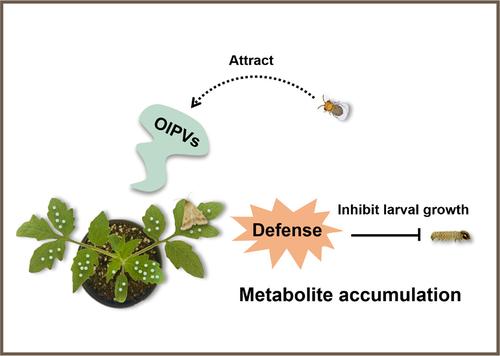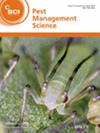求助PDF
{"title":"棉铃虫的产卵刺激了番茄植株对其卵和幼虫的防御能力","authors":"Jin‐Hua Shi, Rui Shao, Sara T Abdelkhalek, Shuo Zhang, Man‐Qun Wang","doi":"10.1002/ps.8521","DOIUrl":null,"url":null,"abstract":"BACKGROUNDHerbivorous insects sustain their populations by oviposition. To reduce the damage caused by herbivores, the host plant triggers a defensive response upon detection of egg deposition. However, the specific impact of the egg deposition time of the cotton bollworm <jats:italic>Helicoverpa armigera</jats:italic> (Lepidoptera: Noctuidae), on the tomato plant defense remains obscure.RESULTSThis study investigated the effects of tomato plant defenses on cotton bollworm eggs and larvae at different time intervals following egg deposition. The study revealed that tomato plant defense triggered by egg deposition did not directly affect the hatchability of the eggs. Nevertheless, it attracted <jats:italic>Trichogramma chilonis</jats:italic> 48 h after the egg deposition. Gas chromatography–mass spectrometry analysis of the oviposition‐induced plant volatiles (OIPVs) revealed a considerable increase in the amount of <jats:italic>α</jats:italic>‐pinene released by tomato plants 48 h after egg deposition. The olfactory results from Y‐tube experiments showed that <jats:italic>α</jats:italic>‐pinene exhibited a substantial attraction towards <jats:italic>T. chilonis</jats:italic>. In addition, it was found that the defense response induced by egg deposition for 24 and 48 h significantly inhibited the growth and development of the larvae. Metabolomics analysis revealed that the egg deposition of cotton bollworm altered the metabolite composition and caused significant modifications in the metabolic pathways of tomato plants.CONCLUSIONThese findings provide novel insights into pest management by using egg‐induced plant defenses to reduce egg hatching, and impede larval growth and development in herbivorous insects. © 2024 Society of Chemical Industry.","PeriodicalId":218,"journal":{"name":"Pest Management Science","volume":"35 1","pages":""},"PeriodicalIF":3.8000,"publicationDate":"2024-11-08","publicationTypes":"Journal Article","fieldsOfStudy":null,"isOpenAccess":false,"openAccessPdf":"","citationCount":"0","resultStr":"{\"title\":\"The oviposition of cotton bollworms stimulates the defense against its eggs and larvae in tomato plants\",\"authors\":\"Jin‐Hua Shi, Rui Shao, Sara T Abdelkhalek, Shuo Zhang, Man‐Qun Wang\",\"doi\":\"10.1002/ps.8521\",\"DOIUrl\":null,\"url\":null,\"abstract\":\"BACKGROUNDHerbivorous insects sustain their populations by oviposition. To reduce the damage caused by herbivores, the host plant triggers a defensive response upon detection of egg deposition. However, the specific impact of the egg deposition time of the cotton bollworm <jats:italic>Helicoverpa armigera</jats:italic> (Lepidoptera: Noctuidae), on the tomato plant defense remains obscure.RESULTSThis study investigated the effects of tomato plant defenses on cotton bollworm eggs and larvae at different time intervals following egg deposition. The study revealed that tomato plant defense triggered by egg deposition did not directly affect the hatchability of the eggs. Nevertheless, it attracted <jats:italic>Trichogramma chilonis</jats:italic> 48 h after the egg deposition. Gas chromatography–mass spectrometry analysis of the oviposition‐induced plant volatiles (OIPVs) revealed a considerable increase in the amount of <jats:italic>α</jats:italic>‐pinene released by tomato plants 48 h after egg deposition. The olfactory results from Y‐tube experiments showed that <jats:italic>α</jats:italic>‐pinene exhibited a substantial attraction towards <jats:italic>T. chilonis</jats:italic>. In addition, it was found that the defense response induced by egg deposition for 24 and 48 h significantly inhibited the growth and development of the larvae. Metabolomics analysis revealed that the egg deposition of cotton bollworm altered the metabolite composition and caused significant modifications in the metabolic pathways of tomato plants.CONCLUSIONThese findings provide novel insights into pest management by using egg‐induced plant defenses to reduce egg hatching, and impede larval growth and development in herbivorous insects. © 2024 Society of Chemical Industry.\",\"PeriodicalId\":218,\"journal\":{\"name\":\"Pest Management Science\",\"volume\":\"35 1\",\"pages\":\"\"},\"PeriodicalIF\":3.8000,\"publicationDate\":\"2024-11-08\",\"publicationTypes\":\"Journal Article\",\"fieldsOfStudy\":null,\"isOpenAccess\":false,\"openAccessPdf\":\"\",\"citationCount\":\"0\",\"resultStr\":null,\"platform\":\"Semanticscholar\",\"paperid\":null,\"PeriodicalName\":\"Pest Management Science\",\"FirstCategoryId\":\"97\",\"ListUrlMain\":\"https://doi.org/10.1002/ps.8521\",\"RegionNum\":1,\"RegionCategory\":\"农林科学\",\"ArticlePicture\":[],\"TitleCN\":null,\"AbstractTextCN\":null,\"PMCID\":null,\"EPubDate\":\"\",\"PubModel\":\"\",\"JCR\":\"Q1\",\"JCRName\":\"AGRONOMY\",\"Score\":null,\"Total\":0}","platform":"Semanticscholar","paperid":null,"PeriodicalName":"Pest Management Science","FirstCategoryId":"97","ListUrlMain":"https://doi.org/10.1002/ps.8521","RegionNum":1,"RegionCategory":"农林科学","ArticlePicture":[],"TitleCN":null,"AbstractTextCN":null,"PMCID":null,"EPubDate":"","PubModel":"","JCR":"Q1","JCRName":"AGRONOMY","Score":null,"Total":0}
引用次数: 0
引用
批量引用



